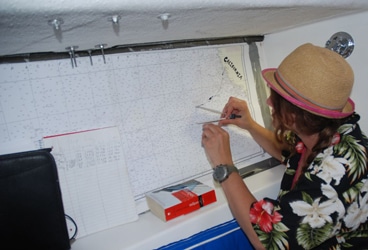
One of the questions I heard most often was, are you going to stop in Hawaii?? If this is purely a research expedition and all of our research is done at sea stopping on land would be an inappropriate use of funding. I would love to sit here and tell you we are researching Piña Coladas on the beach, but that would be a lie. More important than that is the typhoon season is right around the corner. We could survive a tropical storm but a direct hit from a typhoon will kill us, it’s important that we make it to Japan before July 1st. If we keep making good time we should be okay.
Because the open ocean is out of sight it is typically out of mind. There are many misunderstandings. When it comes to plastic trash in our ocean the one I hear most often “is there is an island of trash the size of Texas in the middle of Pacific ocean.” Most people I meet believe this to be true.
The media likes to sensationalize stories and at some point five or six years ago some media outlet came up with the story of an island of trash, and the concept went viral. The truth is there is no island of trash in any ocean. If that was the case the problem would be much easier to solve. If the trash was all in one place we could just go there and clean it up. The reality is much worse than the fairy tale, the ocean is full of plastic trash, microplastics.
There are five major gyres in our Earth’s oceans. A gyre is a very large area dominated by a slow moving vortex like current. There is a gyre in the North Atlantic, South Atlantic, North Pacific, South Pacific, and Indian Ocean. Plastic floats, so if a piece of plastic were to be dumped into the ocean it will ride various ocean currents eventually winding up in one of these gyres. The churning motion of the ocean breaks up larger pieces of plastic into pieces the size of your finger nail or smaller. In the gyre regions, it is estimated that there are 48,000 pieces of broken up plastic per square mile.
Cleaning up the plastic trash is nearly impossible. I heard one estimate that it would take 64 freighter sized vessels working 24 hours a day for 10 years to clean just one gyre. Another problem is that an entire aspect of our oceans ecosystem is living right at the surface, where the microplastics are. If you tried to clean the ocean with a giant net you would destroy this fragile surface ecosystem.
There have been many interesting ideas for cleaning up all of this microplastic trash but none are realistic. The giant trash cleaning robots would be hugely expensive and would be destroyed by the sometimes violent nature of the ocean. I applaud these ideas, I hope a trash cleaning ship or robot can be developed and deployed, but it’s unlikely it will happen any time soon. Microplastics effect both man and marine species. The clearest example of this can be seen with sea birds. Many different bird species spend most of their lives at sea and only come to land to reproduce. It is on these remote islands that people have filmed sea birds feeding their babies plastic and countless other birds dead or dying from ingesting plastics.
It’s much more difficult to monitor the effects on fish, sea turtles, etc. If a fish dies because it has a belly full of plastic it will sink to the bottom of the ocean. The open ocean is on average between 12,000 and 16,000 feet deep. We know more about the surface of the moon than we do about the sea floor. It’s nearly impossible to gauge how many fish are dyeing due to eating micro plastics. Not all fish that eat microplastics will die.
Plastics are full of nasty chemicals, the smaller fish eat the small pieces of plastic thinking its food. They absorb the chemicals into their body during digestion. The larger fish eat many smaller fish, absorbing larger amounts of these pollutants, and we eat the larger fish. We end up eating our own nasty chemicals through this process.
The answer to reducing the amount of plastic trash in our ocean is not at sea, it’s on land. We must reduce the usage of one time use plastic items, increase recycling and promote the use of true bio polymers. For every hour spent collecting samples we have to spend ten hours processing the samples in a laboratory in Baltimore (Baltimore underground science space). We count the amount of microplastics per sample, analyze the DNA of various foreign bacteria hitchhiking a ride on the plastics and also analyze the plastics for different pollutants.
At this point we have no funding to cover any of the processing after this expedition. We are trying to raise $10,000 to cover these costs, at this point we have raised $500. Any size donation helps. Ocean Research Project is a 501 c 3 non-profit so all donations are tax deductible.
Thank you for your help.
We believe that while no one can do everything, everyone can do something. Our project is committed to serving the ocean research community. We provide data that explores man’s relationship with our planet’s oceans. Learn more about the Ocean Research Project at www.oceanresearchproject.org.








